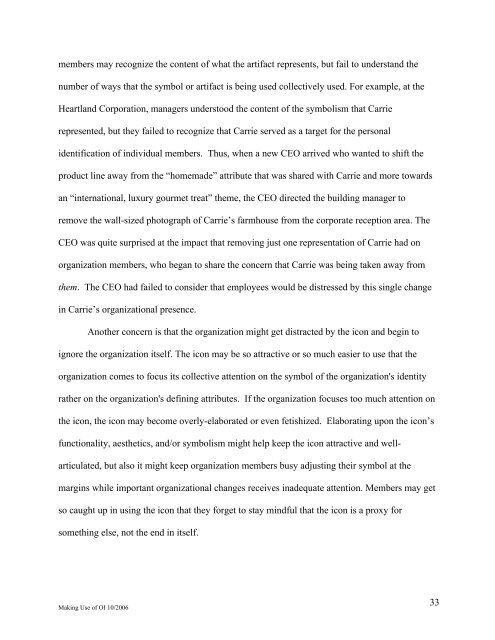Making Use of Organizational Identity - Authentic Organizations
Making Use of Organizational Identity - Authentic Organizations
Making Use of Organizational Identity - Authentic Organizations
You also want an ePaper? Increase the reach of your titles
YUMPU automatically turns print PDFs into web optimized ePapers that Google loves.
members may recognize the content <strong>of</strong> what the artifact represents, but fail to understand the<br />
number <strong>of</strong> ways that the symbol or artifact is being used collectively used. For example, at the<br />
Heartland Corporation, managers understood the content <strong>of</strong> the symbolism that Carrie<br />
represented, but they failed to recognize that Carrie served as a target for the personal<br />
identification <strong>of</strong> individual members. Thus, when a new CEO arrived who wanted to shift the<br />
product line away from the “homemade” attribute that was shared with Carrie and more towards<br />
an “international, luxury gourmet treat” theme, the CEO directed the building manager to<br />
remove the wall-sized photograph <strong>of</strong> Carrie’s farmhouse from the corporate reception area. The<br />
CEO was quite surprised at the impact that removing just one representation <strong>of</strong> Carrie had on<br />
organization members, who began to share the concern that Carrie was being taken away from<br />
them. The CEO had failed to consider that employees would be distressed by this single change<br />
in Carrie’s organizational presence.<br />
Another concern is that the organization might get distracted by the icon and begin to<br />
ignore the organization itself. The icon may be so attractive or so much easier to use that the<br />
organization comes to focus its collective attention on the symbol <strong>of</strong> the organization's identity<br />
rather on the organization's defining attributes. If the organization focuses too much attention on<br />
the icon, the icon may become overly-elaborated or even fetishized. Elaborating upon the icon’s<br />
functionality, aesthetics, and/or symbolism might help keep the icon attractive and wellarticulated,<br />
but also it might keep organization members busy adjusting their symbol at the<br />
margins while important organizational changes receives inadequate attention. Members may get<br />
so caught up in using the icon that they forget to stay mindful that the icon is a proxy for<br />
something else, not the end in itself.<br />
<strong>Making</strong> <strong>Use</strong> <strong>of</strong> OI 10/2006<br />
33


